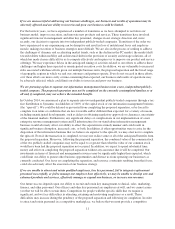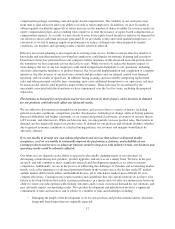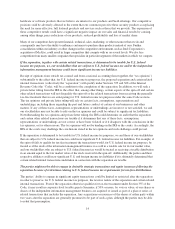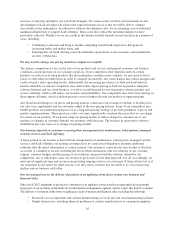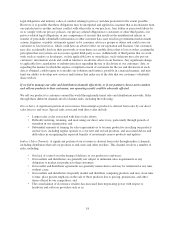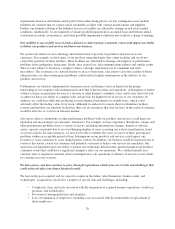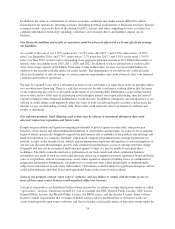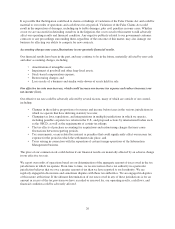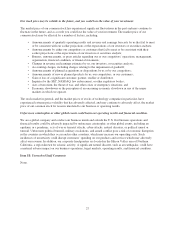Symantec 2015 Annual Report Download - page 97
Download and view the complete annual report
Please find page 97 of the 2015 Symantec annual report below. You can navigate through the pages in the report by either clicking on the pages listed below, or by using the keyword search tool below to find specific information within the annual report.OEM Sales Channels. A portion of our revenues is derived from sales through our OEM partners that incorporate
our products into, or bundle our products with, their products. Our reliance on this sales channel involves many
risks, including:
• Our lack of control over the volume of systems shipped and the timing of such shipments;
• Our OEM partners are generally not subject to minimum sales requirements or any obligation to
market our products to their customers;
• Our OEM partners may terminate or renegotiate their arrangements with us and new terms may be less
favorable due to competitive conditions in our markets and other factors;
• Sales through our OEM partners are subject to changes in general economic conditions, strategic
direction, competitive risks, and other issues that could result in a reduction of OEM sales;
• The development work that we must generally undertake under our agreements with our OEM partners
may require us to invest significant resources and incur significant costs with little or no assurance of
ever receiving associated revenues;
• The time and expense required for the sales and marketing organizations of our OEM partners to
become familiar with our products may make it more difficult to introduce those products to the
market; and
• Our OEM partners may develop, market, and distribute their own products and market and distribute
products of our competitors, which could reduce our sales.
If we fail to manage our sales and distribution channels successfully, these channels may conflict with one
another or otherwise fail to perform as we anticipate, which could reduce our sales and increase our expenses as
well as weaken our competitive position. Some of our distribution partners have experienced financial difficulties
in the past, and if our partners suffer financial difficulties in the future because of general economic conditions or
for other reasons, these partners may delay paying their obligations to us and we may have reduced sales or
increased bad debt expense that could adversely affect our operating results. In addition, reliance on multiple
channels subjects us to events that could cause unpredictability in demand, which could increase the risk that we
may be unable to plan effectively for the future, and could result in adverse operating results in future periods.
Over the long term we intend to invest in research and development activities, and these investments may
achieve delayed, or lower than expected, benefits which could harm our operating results.
While we continue to focus on managing our costs and expenses, over the long term, we also intend to invest
significantly in research and development activities as we focus on organic growth through internal innovation in
each of our business segments. We believe that we must continue to dedicate a significant amount of resources to
our research and development efforts to maintain our competitive position. We recognize the costs associated
with these research and development investments earlier than the anticipated benefits, and the return on these
investments may be lower, or may develop more slowly, than we expect. If we do not achieve the benefits
anticipated from these investments, or if the achievement of these benefits is delayed, our operating results may
be adversely affected.
Changes in industry structure and market conditions could lead to charges related to discontinuances of
certain of our products or businesses and asset impairments.
In response to changes in industry and market conditions, or in connection with our pending separation, we may be
required to strategically reallocate our resources and consider restructuring, disposing of, or otherwise exiting
businesses. Any decision to limit investment in or dispose of or otherwise exit businesses may result in the
recording of special charges, such as inventory and technology-related write-offs, workforce reduction costs,
charges relating to consolidation of excess facilities, or claims from third parties who were resellers or users of
discontinued products. Our estimates with respect to the useful life or ultimate recoverability of our carrying basis
of assets, including purchased intangible assets, could change as a result of such assessments and decisions.
Although in certain instances, our supply agreements allow us the option to cancel, reschedule, and adjust our
19




